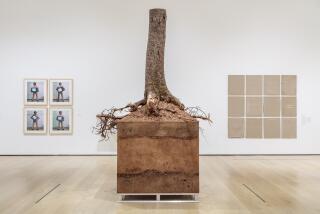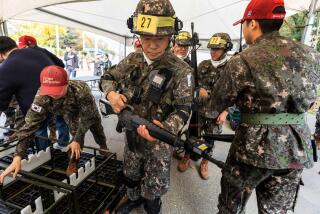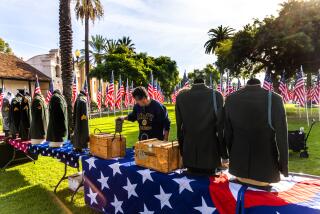40 Years Later--Exhibit Revives Memories of the Korean War
- Share via
Wanjoo Hyun introduces himself as a survivor.
“I was in the first grade when the war began,” Hyun, the 47-year-old owner of a restaurant in Orange, said last week as he visited an exhibit on the Korean War at the Korean Cultural Service in Los Angeles.
“Even though I was very young, I remember most things about the war,” he said, recounting how fighting took the lives of family members and reduced Seoul, his hometown, to rubble.
Hyun’s eyes kept track of his two sons, Arnold, 14, Fred, 12, and their cousins, Edward and Janet Kim, ages 9 and 7, as they perused communist propaganda flyers, bazooka displays and a long-handled land mine detector propped like a mop in the exhibit commemorating the 40th anniversary of the start of the war.
“The children ask me once in a while about what happened,” Hyun said. “I explain my best, but this may be a better way to show them.”
The exhibit, open until Saturday, is one of several recent efforts to pay homage to the veterans who served in a war that took the lives of an estimated 6 million Korean civilians and soldiers from 18 nations.
Like Hyun, Koreans still cling to their memories. America’s recollection of the conflict, though, has been less than vivid.
From June 25, 1950, the day the war began, America’s view of the conflict has been a curious one. Beginning with President Harry S Truman’s insistence on the term police action to describe the U.S. role in the war, America’s reluctance to acknowledge its full participation has been a painful subject for some veterans visiting the gallery.
“Here’s what really ticks me off,” said Pete Hernandez, a former sergeant in the Army’s 187th Airborne Regiment who drove four hours from Visalia to attend the exhibit. “In three years, 54,000 American soldiers got killed fighting the North Koreans. How come the American people don’t know that?”
The death toll of U.S. soldiers during three years of fighting in Korea was close to the 58,000 killed during the decade of warfare in Vietnam.
Coordinator Craig Coleman said the exhibit--titled, “Korea: The Forgotten War, Remembered”-- reflects upon the eerie silence that greeted battle-weary troops when they returned home after a U.N. armistice agreement in 1953.
The agreement, which officially called for a halt to the fighting, did not declare a victor or an end to the dispute, and the Korean War has since carried the inglorious distinction of being the only U.S. war this century that remains unresolved.
“I’ve been bitter since I came home,” Hernandez, 62, said. “Because no one seemed to care. No one seemed to say much about it.”
Korea’s cold war continues. The peninsula, politically apportioned by superpowers after World War II, still is split between the communist North and the capitalist South.
And for 60 million Koreans at home and abroad, June 25 provides modern history’s most prominent reference point. For many Koreans, “before the war” is a phrase used commonly to describe the last time they saw family members who may now be dead, said Sukbong Lee, a retired brigadier general in the South Korean army.
At first, Lee, 66, puzzled over the exhibit’s title, “The Forgotten War,” then found it ironic. One out every 10 Koreans in the world had died during 37 months of warfare.
“How could Koreans forget the war?” he asked incredulously.
More to Read
Sign up for Essential California
The most important California stories and recommendations in your inbox every morning.
You may occasionally receive promotional content from the Los Angeles Times.









